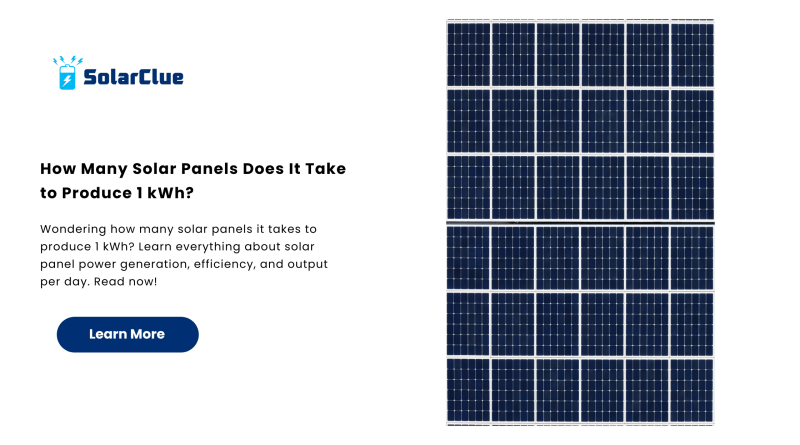How Many Solar Panels Does It Take to Produce 1 kWh?
One of the most common questions from homeowners exploring solar energy is: how many solar panels to produce 1 kWh of electricity? This blog breaks it down in a practical, user-friendly way so you can understand your solar energy requirements and confidently size your solar power system.
To start, it’s essential to know what a kilowatt-hour (kWh) means. A kWh is a unit of energy equal to 1,000 watts used for one hour. This unit is used by utility companies to charge you for the electricity you consume.
Table of Contents
- 1 What Is the Average Solar Panel Output?
- 2 Calculating How Many Panels You Need for 1 kWh
- 3 Factors Affecting Solar Panel Energy Production
- 4 Why Solar Panel Specifications Matter
- 5 Sizing Your Solar Power System Accurately
- 6 Solar Panel Energy Efficiency: Maximizing Output
- 7 Final Thoughts on Solar Panel Energy Production
- 8 FAQs
What Is the Average Solar Panel Output?
The average solar panel output per day depends on several factors, such as location, weather, panel orientation, and shading. On average, a standard solar panel for home produces between 300 to 400 watts under ideal conditions. Over the course of a sunny day, this translates into approximately 1.2 to 1.6 kWh of electricity per panel.
For simplicity, we’ll assume a 350-watt best solar panel with 4 hours of full sun per day. Here’s a quick formula to calculate solar panel output:
Panel Output (kWh) = Panel Wattage × Peak Sun Hours / 1000
So, 350 × 4 / 1000 = 1.4 kWh/day
This means one solar panel can generate roughly 1.4 kWh per day under optimal conditions.
Calculating How Many Panels You Need for 1 kWh
If a 350-watt panel produces 1.4 kWh per day, then to generate 1 kWh, you technically need less than one panel — precisely about 0.71 of a panel. However, since panels come as whole units, you would need at least one panel to generate 1 kWh per day.
But if you want to produce 1 kWh per hour, you’d need more panels. Here’s how to determine it:
Required Wattage = 1000 watts (1 kWh) / 1 hour
If each panel is 350 watts:
1000 / 350 = ~2.86 panels
So, you’d need three solar panels of 350W each to continuously generate 1 kWh every hour under ideal conditions.
Factors Affecting Solar Panel Energy Production
1. Solar Panel Efficiency
The solar panel efficiency defines how well a panel converts sunlight into electricity. Most panels have efficiencies ranging from 15% to 22%. Higher efficiency panels, although costlier, generate more electricity in limited space.
2. Geographical Location
Solar energy availability varies by location. Someone in Chennai will get more sun hours than someone in Delhi during monsoon months. Using a solar energy calculator can help determine location-specific generation.
3. Orientation and Tilt
The angle and direction your solar panels are installed in drastically affect performance. Panels facing south and tilted optimally produce the best results.
4. Temperature and Weather
Oddly, excessive heat can reduce solar panel performance. Similarly, cloudy or rainy days lower solar panel output per day.
Why Solar Panel Specifications Matter

When buying a solar panel for home, don’t just look at price. Key solar panel specifications include:
- Wattage rating (e.g., 330W, 400W)
- Efficiency percentage
- Temperature coefficient
- Warranty period
These impact not only your energy savings but also the solar panel capacity calculation and system sizing.
Sizing Your Solar Power System Accurately
Correct solar panel system sizing is crucial. First, calculate your monthly electricity use. Let’s say you consume 300 kWh monthly:
300 kWh/month ÷ 30 days = 10 kWh/day
If one panel gives 1.4 kWh/day:
10 ÷ 1.4 = ~7.14 panels
So, you’ll need at least 8 solar panels (rounding up) to meet your daily usage under average sun conditions.
Solar Panel Energy Efficiency: Maximizing Output
To enhance solar panel energy efficiency, consider:
- Keeping panels clean
- Installing a solar tracker
- Using micro-inverters
- Monitoring system performance regularly
Higher efficiency equals more solar electricity generation and lower dependency on the grid.
Final Thoughts on Solar Panel Energy Production
Understanding how many solar panels kWh production you need isn’t just about numbers. It’s about achieving independence, saving on bills, and making a greener planet.
We recommend using tools like a solar energy calculator or consulting with experts at solarclue.com for customized recommendations. You can also find more in-depth articles and guides on blog.solarclue.com to further your research.
FAQs
1. Can a single solar panel power a house?
No, one panel can’t power a whole house. You’d need multiple panels based on your energy needs.
2. How many kWh does a house use daily?
An average Indian household uses between 8 to 15 kWh per day.
3. How much space do I need for solar panels?
Typically, each panel needs 15-20 sq. ft. For 10 panels, you’d need around 150-200 sq. ft.
4. Do solar panels work on cloudy days?
Yes, but they produce less energy. Expect 10-25% of their rated output on cloudy days.
5. What maintenance do solar panels need?
Minimal—just regular cleaning and annual system checks for optimal performance.
Interested in going solar? Discover how solar can power your future at solarclue.com and get more tips from blog.solarclue.com—your solar journey starts here!



